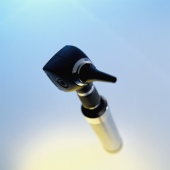- Understanding the Connection Between Anxiety and Depression
- How Daily Prunes Can Influence Cholesterol and Inflammation
- When to Take B12 for Better Absorption and Energy
- Epsom Salts: Health Benefits and Uses
- See What Saffron Can Do for Sleep and Heart Health
- 6 Common Mistakes to Avoid Before Your Physical
- Can Sweating Really Help You Beat a Cold?
- Strengthening Your Relationship: Practical Strategies
- Skip Storing This Everyday Product in the Fridge Door
- Green Tea + B3 Pairing May Boost Brain Health
Nasal Balloon Can Treat Youngsters for ‘Glue Ear’


A simple procedure using what’s known as a “nasal balloon” can treat hearing loss in children with a common middle-ear problem, preventing unnecessary and ineffective treatment with antibiotics, according to a new study.
Many young children develop a condition in which the middle ear fills with thick fluid — so-called “glue ear.” Often, children have no symptoms and parents seek medical help only when they notice that youngsters have hearing problems.
Dr. Jordan Josephson is an ear, nose and throat specialist at Lenox Hill Hospital in New York City. He said that kids are much more prone to glue ear because “the eustachian tube — which is the tube that connects the ear to the back of the nose — gets clogged,” often during a sinus infection, allergy or even pollution-linked inflammation.
Right now, treatments such as “antibiotics, antihistamines, decongestants and intranasal steroids are ineffective and have unwanted effects, and therefore cannot be recommended,” wrote a team of British researchers led by Dr. Ian Williamson of the University of Southampton in England.
In certain cases, drainage tubes can help some children with glue ear, the study authors said.
However, in the new study, Williamson’s team assessed another glue ear treatment — “autoinflation” with a nasal balloon — in a group of 320 children aged 4 to 11 years. During the treatment, the child blows through each nostril into a nozzle to inflate the balloon.
The children were randomly assigned to either use the balloon treatment three times a day for one to three months, or to undergo standard care.
Compared to those in the standard-care group, children who used the balloon treatment were more likely to have normal middle-ear pressure at one month (about 36 percent versus 47 percent, respectively), and at three months (about 38 percent versus 50 percent, respectively). They also had fewer days with symptoms, the researchers reported.
“Autoinflation is a simple, low-cost procedure that can be taught to young children in a primary-care setting with a reasonable expectation of compliance,” according to the study authors, who believe the treatment should be used more widely in children over age 4.
One expert in the United States said the technique is really nothing new.
The nasal balloon “has been around for decades,” Josephson said. “When I treat children with these problems, I tell the parents to have the child blow up balloons and squeeze their nose and try to pop their ears,” he explained.
“This treatment is similar to popping your nose when your ears get clogged on airplanes,” he said.
But another expert stressed that the balloon technique isn’t always the answer.
“While autoinflation presents a non-invasive option in some cases, it cannot always do away with the need for further intervention,” said Dr. Joseph Bernstein, chief of pediatric otolaryngology at Mount Sinai Health System in New York City. He also believes that more study is needed into the effectiveness of the nasal balloon, and possible risks or side effects.
The study was published July 27 in the CMAJ (Canadian Medical Association Journal).
More information
The U.S. National Library of Medicine has more about otitis media with effusion.
Source: HealthDay
Copyright © 2026 HealthDay. All rights reserved.










